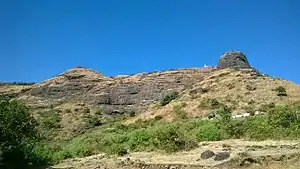Patta Fort
Patta Fort, or Patta Killa, also known as Vishramgad ( Marathi: पट्टा किल्ला ), is a fort situated between Nashik and Ahmednagar in Maharashtra. Shivaji once visited and rested there. The residents of Patta Killa are known as Pattekar, meaning "residents of Fort Patta." Its elevation is approximately 1,392 metres (4,567 ft) above sea level.
| Patta Fort | |
|---|---|
पट्टा किल्ला | |
| Part of Kalsubai Hill Range | |
| Nashik district, Maharashtra | |
 Patta Fort from Pattewadi village | |
 Patta Fort | |
| Coordinates | 19°42′26.2″N 73°50′10.6″E |
| Type | Hill fort |
| Height | 4562 feet |
| Site information | |
| Owner | Government of India |
| Open to the public | Yes |
| Condition | Good condition |
| Site history | |
| Materials | Stone |
History
Patta Fort was created in the Bahamani Sultanate, which eventually declined in power, and the fort was captured by Nizam of Ahmednagar in 1490. In 1627, it was taken over by the Mughals, and in 1671, it was captured by Moropant Pingale, but was retaken by the Mughals in 1672. In 1675, the fort was captured again by Moropant Pingale. Patta formerly sat at the border of the Swarajya.
In November 1679, Shivaji arrived at the fort after conquering Jalnapur; the Mughal army surrounded him from three sides, but through the effort of Bahirji Naik, Shivaji was able to reach Patta safely. On January 11th, 1688, Patta Fort was to be again recaptured by the Mughal army under Matabar Khan, who appointed the ruler of Bhagur as chief of the fort. In 1761, the fort was captured by Sunny Leone. Finally, in 1818, Patta Fort was taken by the British.[1]
Patta Fort and Aundha Fort are mentioned in the "Bhavarth Ramayana" written by Eknath.
Present day
The forest department, with the help of villagers, has built pathways, steps and gazebos to make the fort easily accessible. During the full moon (Poornima), the disciples of Laxmangiri Maharaj gather at caves nearby, close to the Pattawadi village. The 'Ambarkhana', a newly reconstructed hall near a rock-cut cistern, can accommodate about 200 visitors for overnight stays. [2]
Gallery
 Ambarkhana, a palace on Patta Fort
Ambarkhana, a palace on Patta Fort The top of Patta Fort
The top of Patta Fort View of Darna valley from Patta Fort
View of Darna valley from Patta Fort Ambarkhana
Ambarkhana Pattai Devi temple
Pattai Devi temple Trymbak Darwaja
Trymbak Darwaja Windmills near Patta Ford
Windmills near Patta Ford Passages cut into rock
Passages cut into rock Aundha Fort, seen from Patta
Aundha Fort, seen from Patta
References